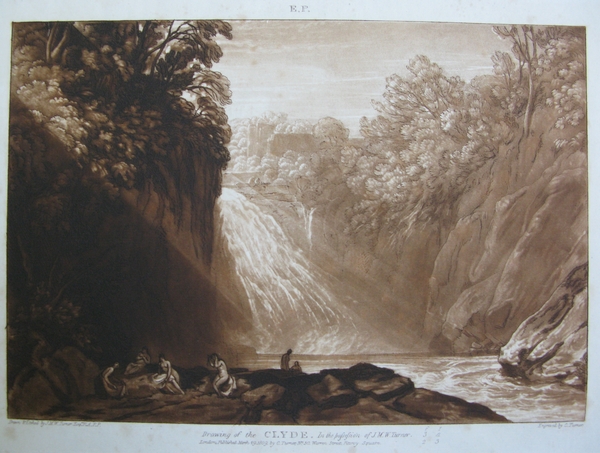The Fall of the Clyde
Joseph Mallord William Turner 1775 - 1851
Summary
This is a landscape with river running to the left between two large cliffs in the background. On the left there is a waterfall with rays of the sun shining with it. In the foreground there are several figures: nude females with some drapery sit on the rocks. There are four figures to left facing forward and two figures closer to the edge of the water. There are trees above the cliffs and a building on the higher ground behind the waterfall. There are dark shadows cast over the cliffs on the left.
Display Label
A Highland Romance: Victorian Views of Scottishness The popular idea of Scottishness in the 1800s came from Sir Walter Scott (1771–1832), who fictionalised exciting episodes from Scottish history. He created a colourful Highland identity for his nation, based on the customs and landscape of the sparsely populated mountainous areas. For Lowland Scots – the majority of the population – it was a fiction they took up gladly, perhaps because it emphasised difference from the English. However, most Victorians, Scots and English, felt cultural difference to be perfectly compatible with political union. Queen Victoria’s regular visits to Scotland encouraged the English to view it as a simple country retreat. By the end of her reign her wealthier English subjects came to regard Scotland principally as an arena for shooting, fishing and golf. Artists from both sides of the border visualised the stags, castles, mountains and tartan that made up this Victorian myth. Their paintings reaffirmed impressions gleaned from Scott’s novels and from tourist guide books to Scotland. The fact that Scotland was an industrialised nation taking an active part in the British Empire was largely ignored. Popular art and literature fed the ‘tartan monster’, refining a checklist of clichés that even today remain key to the marketing of Scotland. A number of local industrialist patrons who bought paintings with Scottish subjects later gave them to Manchester Art Gallery. As a result the Gallery has a particularly good late Victorian collection. Here is ‘Scottishness’, as seen from Manchester in the late 1800s.
Object Name
The Fall of the Clyde
Creators Name
Date Created
1809
Dimensions
print: 20.9cm x 28.9cm
support: 29.9cm x 43.7cm
accession number
1918.1009/11
Collection Group
Place of creation
Europe
Support
paper
Medium
ink (brown)
Credit
Transferred from the Horsfall Museum Collection, 1918

